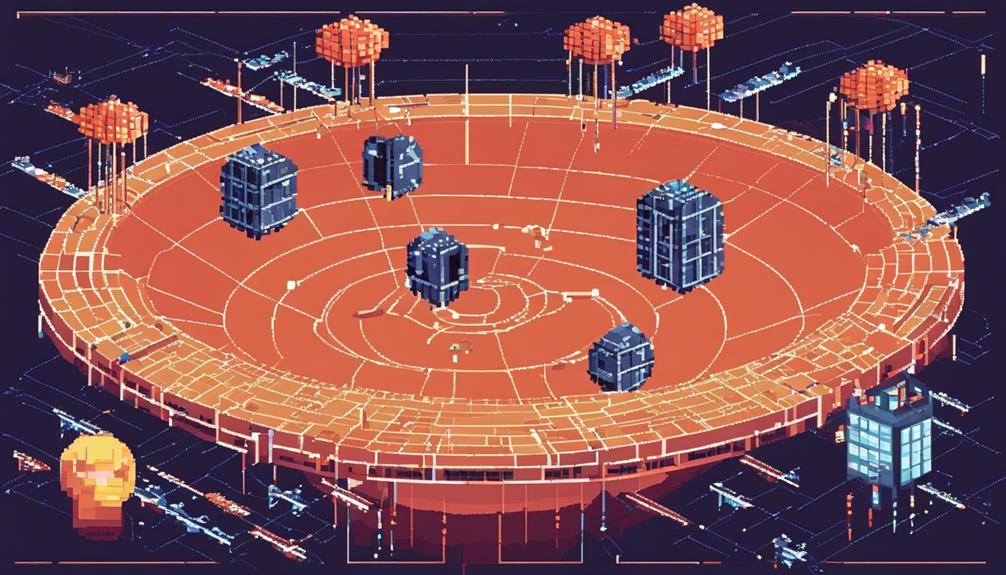In the realm of satellite networks, cybersecurity regulations stand as the cornerstone in fortifying the resilience of these critical systems against a myriad of cyber threats. Ensuring the secure operation of satellite networks encompasses a complex interplay of technical, regulatory, and operational considerations. From encryption protocols to incident response strategies, the landscape of satellite cybersecurity is multifaceted and ever-evolving. As satellite networks continue to underpin essential services and national security interests, exploring the nuances of cybersecurity regulations in this domain unveils a tapestry of challenges and opportunities that warrant meticulous attention and strategic foresight.
Key Takeaways
- Implementation of voluntary recommendations under the Satellite Cybersecurity Act for enhanced security.
- Adherence to NIST Framework and tailored guidelines crucial for robust cybersecurity posture.
- Protection of critical infrastructure, government systems, and space systems through effective regulations.
- Embracing best practices like access controls, encryption, monitoring, and incident response plans for satellite network security.
Satellite Cybersecurity Regulations Overview

Drafting voluntary recommendations, the Satellite Cybersecurity Act aims to enhance security measures for satellite systems. These recommendations encompass various aspects of cybersecurity to fortify satellite networks against potential threats. Key elements include risk-based monitoring, control retention, and protection guidelines to assist satellite operators in bolstering their security postures. By providing voluntary standards, the act sets the stage for potential future direct regulations that could further strengthen cybersecurity within satellite operations.
In implementing these recommendations, stakeholders are encouraged to conduct thorough security reviews. This involves activities such as mapping inventories, monitoring anomalies, and automating vulnerability management processes. By following these guidelines, satellite operators can effectively mitigate risks and enhance the overall security of their systems.
Furthermore, the act emphasizes the importance of maintaining control retention to ensure that critical assets and functions remain protected. Security postures need to be continuously evaluated and improved to adapt to evolving cyber threats. By adhering to these voluntary standards, satellite operators can proactively safeguard their networks and contribute to the overall resilience of satellite systems in the face of cybersecurity challenges.
Compliance Standards for Satellite Networks
Satellite networks are required to adhere to specific compliance standards, which encompass cybersecurity regulations such as the NIST Cybersecurity Framework and industry-specific guidelines like those outlined in the Satellite Cybersecurity Act recommendations. Compliance standards for satellite networks play a crucial role in ensuring the security and resilience of these systems, especially as they are considered critical infrastructure within the space sector. To meet these standards effectively, satellite operators may need to consider the following:
- Hybrid Satellite Networks: Integration of terrestrial and satellite capabilities requires a nuanced approach to cybersecurity to address the unique challenges posed by hybrid networks.
- Framework Profile for Hybrid: Developing a tailored framework profile that combines elements of the NIST Cybersecurity Framework with industry-specific standards can enhance the security posture of hybrid satellite networks.
- Independently Owned and Operated: Satellite systems are often independently owned and operated, necessitating robust cybersecurity risk management practices to safeguard against potential threats.
- Security Reviews: Regular security reviews for satellite operations are essential, involving activities such as mapping inventories, monitoring anomalies, and automating vulnerability management.
- Compliance Standards Implementation: Satellite cybersecurity regulations emphasize the need for effective implementation of risk-based monitoring, control retention, and protection guidelines to mitigate security risks effectively.
Impact of Cybersecurity Regulations on Satellites

Effective implementation of cybersecurity regulations plays a pivotal role in safeguarding satellite systems against cyber threats and ensuring their resilience in the face of evolving security challenges. Satellite operators must adhere to cybersecurity regulations to protect critical infrastructure, government systems, and space systems from vulnerabilities. Compliance with regulations such as the Cybersecurity Framework Profile by NIST is crucial for enhancing the security posture of hybrid satellite networks.
To better understand the impact of cybersecurity regulations on satellites, let's examine the following aspects:
| Aspect | Description | Importance |
|---|---|---|
| Compliance Measures | Ensuring satellite operators comply with cybersecurity regulations to mitigate risks and vulnerabilities | Essential for security |
| Regulatory Framework | Implementing guidelines like NIST Cybersecurity Framework to establish best practices in satellite security | Enhances overall resilience |
| Protection of Critical Systems | Safeguarding critical infrastructure, government, and space systems from cyber threats | Ensures operational continuity |
Best Practices for Satellite Network Security
The implementation of robust security measures is imperative for safeguarding satellite networks against cyber threats and ensuring the resilience of critical infrastructure. When it comes to securing satellite networks, the following cybersecurity best practices are essential:
- Access Controls: Implementing strong access controls restrict unauthorized users from gaining entry into sensitive areas of the satellite network.
- Encryption Methods: Utilizing advanced encryption methods helps in protecting data transmission and storage within satellite networks from potential breaches.
- Security Incidents: Regularly monitoring satellite systems for security incidents allows for early detection, response, and mitigation of potential threats.
- Incident Response Plans: Developing comprehensive incident response plans ensures that cybersecurity incidents are contained efficiently, minimizing their impact on satellite network operations.
- Personnel Training: Training personnel on cybersecurity best practices and conducting security awareness programs fosters a culture of security consciousness within satellite network operations.
Future Trends in Satellite Cybersecurity

What novel technologies are driving the evolution of cybersecurity strategies in satellite networks? Future trends in satellite cybersecurity are marked by the integration of artificial intelligence (AI) for advanced threat detection capabilities. AI algorithms can analyze vast amounts of data in real-time, helping to identify and respond to potential cyber threats more effectively. Additionally, quantum-resistant encryption is a crucial focus for enhancing the security of satellite communications. As quantum computing poses a threat to traditional encryption methods, developing secure communication networks with quantum-resistant encryption is paramount to safeguarding data integrity and confidentiality in satellite operations.
Moreover, the future of satellite cybersecurity involves bolstering resilience and redundancy measures to mitigate the impact of cyber incidents on satellite systems. Hybrid satellite networks that combine different technologies and architectures are being explored to enhance overall cybersecurity posture. Workforce training programs are also being emphasized to ensure that personnel are equipped with the necessary skills to address evolving cybersecurity challenges in satellite networks effectively. By staying ahead of emerging threats through advanced technologies and comprehensive training, the satellite industry can better protect its critical infrastructure and data assets.
Frequently Asked Questions
How Satellites Are Protected From Cyber Attacks?
Satellites are shielded from cyber attacks through a multi-layered approach that includes satellite encryption, secure protocols, access control, data encryption, incident response plans, threat detection, network monitoring, vulnerability assessment, security patches, and authentication mechanisms. These protective measures ensure the integrity and security of satellite networks by preventing unauthorized access, detecting anomalies, and responding swiftly to potential threats, thereby safeguarding critical satellite operations.
What Is a Cybersecurity Framework for Mitigating Risks to Satellite Systems?
In addressing risks to satellite systems, a comprehensive cybersecurity framework encompasses various facets such as risk assessment, network security, threat detection, vulnerability management, incident response, data encryption, access control, authentication methods, security monitoring, and compliance measures. These elements work in concert to fortify satellite networks against potential cyber threats, ensuring the integrity and functionality of critical space-based infrastructure.
What Are the Three Main Cybersecurity Regulations?
The three main cybersecurity regulations are essential for safeguarding satellite networks. These regulations encompass a wide range of measures, including data encryption, access control, incident response, vulnerability scanning, penetration testing, security awareness, patch management, threat intelligence, and security audits. By adhering to these regulations, organizations can enhance the security posture of their satellite systems, mitigate cyber threats, and ensure the integrity and availability of critical satellite services.
What Are Regulatory Requirements in Cyber Security?
Regulatory requirements in cybersecurity encompass a spectrum of measures to fortify digital defenses. These include data encryption to safeguard sensitive information, network monitoring for proactive threat detection, incident response plans to mitigate breaches swiftly, access control mechanisms for limiting unauthorized entry, vulnerability scanning to identify weak points, security awareness training for personnel, patch management for system updates, risk assessments for preemptive risk mitigation, compliance audits to ensure adherence, and threat intelligence to stay ahead of evolving threats.

